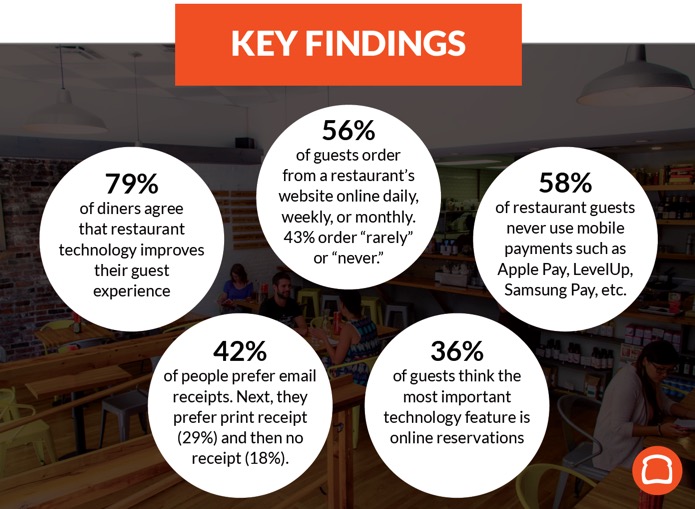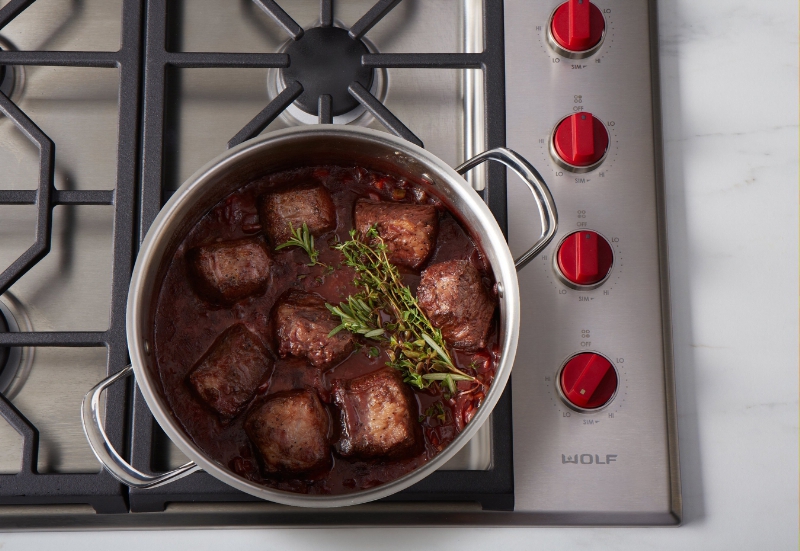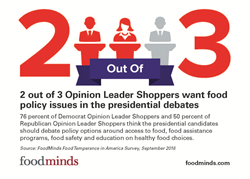According to a Recent Study/Survey … Mid-October 2016 Edition
14 Min Read By MRM Staff
As part of our mission to be the go-to resource for on-the-go restaurant industry professionals, Modern Restaurant Management magazine (MRM) offers highlights of recent research. This mid-October edition features news about the Tech effect on guest experience, best and worst foodie cities and culinary trends for 2017 including Wake and Cake and Snackin’ Sardines.
Tech’s Impact on Guest Experience
Seventy-nine percent of consumers agree that technology improves their restaurant experience, according to a survey conducted by Toast Restaurant POS, the all-in-one restaurant technology platform. The finding was unveiled as part of the Toast Restaurant Technology in 2016 Dining Report, released today, which analyzes responses from more than 1,100 diners, revealing how they feel about consumer-facing technologies in the restaurant space – including identifying the technologies they use most frequently, and those they could do without.

According to the study, a significant 88 percent of participants report that they have placed an online order through a restaurant’s website, with 27 percent stating they use online ordering on a weekly basis. Further, 62 percent of respondents have chosen to place mobile orders using their smartphones or tablets when this technology option has been available.
Among the technology features consumers find most important, online reservations topped the list with 36 percent of votes, followed by free WiFi at 23 percent and mobile or online ordering at 19 percent.
“Consumers overwhelmingly agree that technology is improving the way they engage with restaurants and enhances their overall dining experience,” said Chris Comparato, CEO of Toast. “The study’s findings not only provide deep insight into the impact of restaurant technology tools and trends but also serve to help restaurant owners and managers prioritize how to invest in new capabilities for 2017 and beyond.”
Additional findings include:
- While 82 percent of diners still prefer receipts, 42 percent of diners today request to receive receipts via email, while 11 percent request mobile receipts;
- 42 percent of respondents have used mobile payments such as Apple Pay, LevelUp, Samsung Pay, etc.;
- Delicious food remains the number one factor in a good restaurant experience according to 60 percent of diners, while quality service ranked second at 22 percent.
To access the full report, click here.
Toast conducted an online survey from July 27 to August with 1,115 respondents drawn from a nation-wide consumer audience.
Best and Worst Foodie Cities
With Oct. 16 being World Food Day and Americans spending more money at food establishments than at grocery stores in 2015, personal-finance website WalletHub took a close look at 2016’s Best & Worst Foodie Cities.
To find the best and cheapest foodie scenes in the U.S., WalletHub compared the 150 most populated cities across 21 key metrics, ranging from “cost of groceries” to “affordability and accessibility of high-quality restaurants” to “number of food festivals per capita.”
| Best Foodie Cities | Worst Foodie Cities | ||||
| 1 | Orlando, FL | 141 | Garland, TX | ||
| 2 | Portland, OR | 142 | Fayetteville, NC | ||
| 3 | Miami, FL | 143 | Jackson, MS | ||
| 4 | Tampa, FL | 144 | San Bernardino, CA | ||
| 5 | San Francisco, CA | 145 | Aurora, IL | ||
| 6 | Cincinnati, OH | 146 | Fontana, CA | ||
| 7 | St. Louis, MO | 147 | Montgomery, AL | ||
| 8 | Salt Lake City, UT | 148 | Grand Prairie, TX | ||
| 9 | Richmond, VA | 149 | Moreno Valley, CA | ||
| 10 | Seattle, WA | 150 | North Las Vegas, NV | ||
- Laredo, TX, has the lowest grocery cost index, 79, which is two times lower than in Honolulu, the city with the highest, 158.9.
- Orlando, FL, has the most restaurants per 100,000 residents, 1,176.38, which is 9.8 times more than in Santa Clarita, Calif., the city with the fewest, 120.09.
- Santa Rosa, CA, has the highest ratio of full-service restaurants to fast-food establishments, 1.74, which is 3.1 times higher than in Jackson, Miss., the city with the lowest, 0.57.
- Portland, OR., has the most coffee and tea shops per 100,000 residents, 103.92, which is 29.5 times more than in Laredo, Texas, the city with the fewest, 3.52.
- Miami has the most gourmet specialty-food stores per 100,000 residents, 117.46, which is 14.5 times more than in Gilbert, Ariz., the city with the fewest, 8.08.
- Cincinnati has the most grocery stores per 100,000 residents, 128.29, which is 13.8 times more than in Santa Clarita, Calif., the city with the fewest, 9.32.
- San Francisco has the most cooking schools per 100,000 residents, 6.36, which is 28 times more than in Raleigh, N.C., the city with the fewest, 0.22.
In order to determine the best and cheapest foodie scenes in the U.S., WalletHub’s analysts compared the 150 most populated cities across two key dimensions, including “Affordability” and “Diversity, Accessibility & Quality.” They next evaluated these categories using 21 relevant metrics. Each metric was graded on a 100-point scale, with a score of 100 representing the best conditions and costs for foodies. Then they calculated overall scores for each city using the weighted average across all metrics and constructed final ranking based on the results. To view the full report, click here.
Consumers Want Human and Digital Interaction
Consumers spend twice as much in-store when they receive assistance from a retail sales associate and 2.2 times more when they visit the brand’s website in-store, according to new data from cloud-based customer experience (CX) optimization company, InMoment.
“For brands, it’s not about choosing one channel over the other, but rather leveraging each for their unique strengths. Online storefronts can showcase selection, while your people can provide personalized care. It’s this combination of the human and the digital that increases conversions as well as overall brand loyalty.”
In its 2016 Retail Industry Report, InMoment surveyed more than 25,000 North American consumers on their experiences throughout their shopping journey, from their decision to visit the store to the in-store experience and their feelings post-purchase. The report found that a consumer’s average single-trip spend increases nearly four times when engaged by both in-store staff and the brand’s website. This indicates that the more help a consumer receives, whether digital or human, the more he or she is willing to spend.
Other key findings include:
- Consumers that visited another brand’s website while in store spent, on average, 1.2 times more than those who did not.
- Of those who visit the brand’s website while in a store location, 72 percent were younger than 44 years old, with the highest proportion of visitors (26.1 percent) coming from the 35-44-year-old demographic.
- Consumers ages 18-24 are almost twice as likely to visit the brand’s website before a store visit when compared to all other age groups.
“Despite fears that brick-and-mortar buying might lose its relevance, in-person shopping has transformed into an omnichannel opportunity to sell more, and deepen customer relationships,” said Dr. Paul Warner, vice president, consumer and employee insights at InMoment. “For brands, it’s not about choosing one channel over the other, but rather leveraging each for their unique strengths. Online storefronts can showcase selection, while your people can provide personalized care. It’s this combination of the human and the digital that increases conversions as well as overall brand loyalty.”
The study also includes insights on consumers’ shopping habits across industries. According to the report, the technology and entertainment sectors saw the largest increase in spend (3.9 times greater) when consumers reported having an interaction with staff versus those who did not. Fashion retailers in particular saw a significant increase in spend (more than 2.5 times) when consumers engaged with a competitor’s website and interacted with staff.
To download the study, click here.
Top 10 Culinary Trends
Sterling-Rice Group (SRG) identified its top ten culinary trends that will stand out on restaurant menus, expand onto grocery shelves, and attract consumer attention across the U.S. in 2017.
Broad and growing interest in wellness and the environment, as well as a strong desire to connect with international cultures, continue to be significant key factors influencing the way U.S. consumers eat and drink. In 2017, chefs and foodies alike—seeking authenticity—will be inspired by ancient wellness philosophies and traditional cooking methods to create new and exciting menu items and elevated dining experiences.
Look for these culinary trends to expand and grow next year as they move from cutting edge to mainstream:
- Wake and Cake: Have your cake and eat it … for breakfast? With recent science and research endorsing this diet strategy, in the year ahead SRG expects more people to partake in this decadent post-breakfast trend.
- Dosha Dining: Long recommended as medicine by Siddha doctors (traditional Indian physicians), turmeric came into the spotlight in 2016 boasting its mega-health benefits and savory flavor. With sustained interest in food as medicine, consumers will take a deeper dive into the ancient practice of Ayurveda and eat for their doshas.
- Plant Butchery: Meat substitutes have graduated from seitan and soy with new options made from chickpeas, legumes, and fungi. Mock meats are popping up in their own butcher-style storefronts, enticing a new generation to consider Meatless Monday, Tuesday, Wednesday…
- Food Waste Frenzy: With approximately 40% of food in the U.S. going to waste, restaurants, and innovative food companies will increasingly serve up delicious food options using the whole fruit and vegetable—from seeds to rinds.
- Snackin’ Sardines: In 2017, consumers will fish for more protein-rich snacks. High in omega-3s, protein, and umami flavoring, sardines will move to the forefront as an uncomplicated yet elegant addition to any snacking situation.
- Noodle on This: Noodle lovers who have long embraced Thai pad see ew, Vietnamese pho, and fresh Japanese ramen are rediscovering Chinese lamian—or hand-pulled noodles—for both their taste and entertainment value. Watching a master noodle-smith knead, stretch, and swing dough into strands for soup will be a new experience for eaters who not only enjoy good food, but also a good show.
- Mocktail Mixology: From nonalcoholic happy hours to standalone mocktail menus, beverages are being positioned as intricate and unique experiences that can be had without the hangover.
- Goat! Get It. Low in calories, fat, and cholesterol, goat is poised to become the next go-to protein in 2017. A great foundation for spicy and sour preparations, look for restaurants to feature goat in dishes, such as empanadas and lasagna.
- Cook and Connect: Chefs, home cooks, and foodies are taking advantage of the sharing economy and coming together in a big and innovative way—from communal pizza ovens and outdoor kitchens to the fleet-farming movement.
- Migratory Meals: All over the world people are moving; some by choice, others under duress. By celebrating their rich heritages and cuisines, large refugee populations are beginning to make culinary connections with their new home countries.
The report was compiled by an in-house culinary team and SRG’s Culinary Council, a team of more than 175 chefs, restaurateurs, and foodies. An extension of Culinary Shifts, SRG’s annual proprietary report on key societal shifts driving long-term food trends, Culinary Trends provides insights that food industry companies can leverage to better develop, position, market, and sell their products.
For a complete look at cutting-edge Culinary Trends 2017, click here.
Home Cooking Quirks
One quarter of Americans would rather watch a cooking show than cook a meal, according to the results of a new survey from Wolf Appliance, Inc. The company surveyed American adults about their cooking attitudes and behaviors as part of its Reclaim the Kitchen initiative.
“More than one third of adults say they spend more time in the kitchen than they have in the past, but about 42 percent also say they would rather scroll through social media than cook,” said Brian Jones, Director of Marketing for Wolf Appliance, Inc. “This tells us that we have a gap to close. Americans are interested in home cooking, but there is a need for a basic, accessible means for them to get back into their kitchens. Reclaim the Kitchen is meant to inspire people to shift from admiring food, to having the skills and understanding to cook the types of foods that appeal to them.”

The survey findings also show that one in six adults will order takeout if a meal takes longer than 30 minutes to cook. Other cooking quirks include:
- Adults are most comfortable using their microwaves and ovens, and nearly one in five adults use their oven only on occasion or during the holidays.
- 43 percent of adults say they are too tired to cook, even when they have the time.
- 50 percent of adults can’t name 10 items currently located in their pantry.
- 39 percent of adults have set off the fire alarm when cooking.
- Adults throw away $500 worth of food annually, and 56 percent are very concerned about food waste.
And while millennials strongly identify with food, they are more likely to avoid cooking:
- Nearly 70 percent of millennials say learning to cook new dishes or cuisines is a personal accomplishment that is important to them.
- 58 percent of millennials said they occasionally eat snack or junk food for dinner.
- 21 percent of millennials have never boiled an egg.
- Less than half of millennials know how to dice, sauté, broil, mince, sear or braise food.
The survey was conducted online for Wolf by Russell Research between August 5, 2016 and August 8, 2016 among 1,059 adults ages 18 and older. The margin of error is +/‑ 3.1 percent.
Bundle Trouble
A new survey of children’s and teenagers’ eating habits at fast-food restaurants suggests that consumption levels of sugary drinks are closely tied to their automatic inclusion in “combo meal” packages. According to the NYU Langone Medical Center researchers who led the survey, kids who ate at any of five major fast-food chains consumed 179 more calories on average when their meal deals included soda, sweetened tea or juice, or flavored milks, compared to those who drank non-sweetened beverages or nothing with their food.
In a summary of the results, published in the American Journal of Public Health, researchers also found that purchasing drinks as part of bundled meals was tied to the consumption on average of 82 more drink calories than when the drinks were purchased separately. And, they reported, parents who bought combo meals were 24 percent more likely than those who did not to buy a high-calorie, sugar-sweetened beverage than a non-sweetened drink or no beverage.
“Our study strongly suggests that uncoupling sugary drinks from combo meal deals might reduce high-calorie beverage consumption and help to curb childhood obesity rates fueled by these kinds of liquid calories,” says study senior investigator Brian Elbel, PhD, an associate professor in the Department of Population Health at NYU Langone, and at the NYU Wagner Graduate School of Public Service.
For the study, Elbel’s team surveyed fast-food restaurant eating choices of 483 boys and girls between the ages of 1 and 18 who dined in or took food to go from a McDonald’s, Burger King, KFC, Wendy’s or Subway between January 2013 and June 2014. All restaurants involved in the survey were located inNew York or in Newark or Jersey City, NJ, and the parents of all dining youth were interviewed about their purchases based on meal receipts.
The high calorie levels calculated by the research team among youthful diners mean it is highly likely that added sugar intake from such drinks causes many of them to exceed the maximum, recommended limit of between 120 and 180 calories set in U.S. national dietary guidelines, say the study authors. Elbel points out that about 17 percent of Americans under the age of 19 are estimated to be obese, a situation caused in part by people’s consumption of too many calories from sugar. The researchers say their analysis is the first to assess factors that may be driving sugary drink consumption at fast-food restaurants.
Overall, among those surveyed, fewer than half (42 percent) purchased a combination meal, but 74 percent of combo purchases were kids’ meals, Elbel reports. The survey also found that about half of all beverages (49 percent) were sodas. The rest were juice (38 percent), flavored milk (5 percent), regular milk (2 percent), and water (1 percent). Another 5 percent consisted of sweetened teas, lemonade, and hot chocolate. Those who bought their meals “to go” averaged 14 fewer drink calories than those who ate in the restaurant.
Age and gender mattered as well — but less so than combo meals — in the purchasing of sugary drinks, according to the survey analysis. Teenagers were 22 percent more likely to drink them than younger children, and males were 31 percent more likely than females.
The new analysis, Elbel says, comes in the wake of efforts by several cities to restrict access to supersized soft drinks, mainly by imposing higher sales taxes. Such taxes failed to pass in New York City in 2014, but were later that year introduced in Berkeley, Calif., and this year in Philadelphia.
“Although our study does not prove cause and effect with respect to obesity and bundled fast-food meals,” Elbel says, “policy-makers will ideally be able to use research like ours to guide them in formulating public health policies that may effectively decrease consumption of unhealthy sugar-sweetened beverages.”
Funding for the study was provided by the National Institutes of Health, including National Institute of Diabetes and Digestive and Kidney Diseases grant R01 099241, and National Heart, Lung, and Blood Institute grant R01 HL095935. Additional funding support was provided by New York State Health Foundation grant 12-01682, and Robert Wood Johnson Foundation grant 70823. In addition to Elbel, other NYU Langone researchers involved in this study are doctoral candidates Jonathan Cantor, MS; and Andrew Breck, MPA.
Food Policy Up for Debate
FoodMinds’ fourth “Food Temperance in America” survey found two out of three Opinion Leader Shoppers – registered voters that express their food values in the grocery store, in public forums and in their politics – support including food policy issues in the presidential debates, with 76 percent of Democrat Opinion Leader Shoppers and 50 percent of Republican Opinion Leader Shoppers thinking the presidential candidates should debate policy options around access to food, food assistance programs, food safety and education on healthy food choices. There was an uptick among Republican Opinion Leader Shoppers calling for the inclusion of food issues in the debates, with only 42 percent of this group favoring food policy deliberation in 2012, the last time FoodMinds conducted the survey.
While food policy approaches differ between Democrats and Republicans, there has been a significant shift since 2010 in Opinion Leader Shoppers’ thinking about who holds the primary responsibility for making the right food choices to stay healthy and avoid obesity.
“Since the FoodMinds Food Temperance Survey was first fielded in January 2010, there has been a steady shift in perceived responsibility away from the individual and toward other parts of society including food companies, government, health care and education,” said Grant Prentice, senior vice president, strategic insights, FoodMinds. “In fact, during this six-year time frame there has been a 15-point change among Opinion Leader Shoppers, with more than 50 percent of such shoppers now believing the primary responsibility for making the right food choices lies with society rather than the individual.” While Republican Opinion Leader Shoppers are more likely to place responsibility on the individual compared to Democrats, the percent of Republicans focused on individual responsibility dropped from 67 percent in 2012 to 59 percent in 2016.
The “Food Temperance in America” survey tracks opinions on food policy topics among registered voters and Opinion Leader Shoppers, a group of politically aware and socially active consumers who are registered voters and primary grocery shoppers for their households.Democrat Opinion Leader Shoppers show much stronger approval for government intervention to limit consumption of unhealthy foods, with 71 percent approving increased intervention relative to only 34 percent of Republicans approving of increased government intervention in food choice and efforts to limit consumption of unhealthy foods.
“It is clear that Republican and Democratic Opinion Leader Shoppers hold different opinions on food policy and these voters want Hillary Clinton and Donald Trump to debate pressing food policy matters during this election. Given the significant difference of opinion on best policies to adopt, it is imperative that the country engage in this debate,” said Bill Layden, founder and executive vice president, FoodMinds.
Millennials Want Work-Life Balance
According to FlexJobs’ survey, travel is a surprisingly popular motivator for why people work: 70 percent of millennials say the desire to travel is a primary reason to work, second only to paying for basic necessities (88 percent). Gen X respondents ranked travel (60 percent) as the fourth most important reason for working, and boomers ranked travel (47 percent) fifth in importance. Fifteen percent of millennials in the survey identified as digital nomads/travelers, compared to 11 percent of gen X and eight percent of boomers.
While work-life balance, workplace flexibility, and salary are the top three factors the three generations consider when evaluating a job prospect, rankings vary: 82 percent of millennials cite work flexibility as a factor compared to 81 percent of gen X and 79 percent of boomers. Work schedule was also more important to millennials (65 percent), whereas only 57 percent of gen X and 62 percent of boomers said it was a consideration.
“Since millennials are now the largest generation in the U.S. labor workforce, it’s critical that companies pay attention to how, where and when they work best,” said Sara Sutton Fell, Founder and CEO of FlexJobs. “82 percent of millennials said they would be more loyal to their employers if they had flexible work options and nearly a quarter would be willing to work more hours. So offering millennials work flexibility isn’t just a strategy to avoid negative consequences like losing talent–employers have a lot to gain by modifying their strict, traditional, office-based model of working.”
Other findings include:
Millennials Place High Value on Work Flexibility
Millennials place an extremely high value on work flexibility:
- Work-life balance (84 percent) was ranked the most important factor when evaluating a job prospect.
- Work flexibility came in as the second most important factor (82 percent), and salary ranked third (80 percent), all ranked well above other factors such as health insurance (48 percent), company reputation (45 percent), and 401(k)/retirement benefits (36 percent)
- 34 percent have actually left a job because it did not have work flexibility
- 14 percent have considered leaving a job because it did not have work flexibility
- 24 percent are currently looking for a new job because of work flexibility issues
Workstyle Reasons Millennials Are Interested in Work Flexibility
Work flexibility appeals to different groups within the generation.
- Millennials identified primarily with the following groups: working parents (40 percent), freelancers (26 percent), introverts (30 percent), entrepreneurs (18 percent), students (17 percent) and digital nomads (15 percent)
- Millennials interested in work flexibility are highly educated and experienced workers. Seventy-four percent of respondents have a college or graduate degree and 20 percent are already manager level or higher.
Employer Benefits
Millennials report being willing to make bottom-line saving sacrifices in exchange for telecommuting options:
- 35 percent of respondents said they would take a 10 percent or 20 percent cut in pay
- 27 percent are willing to forfeit vacation time
- 22 percent would be willing to work more hours
- 82 percent of respondents also say they would be more loyal to their employers if they had flexible work options
- 60 percent of millennials think they would more be more productive at home vs an office
Generational differences
- While millennials tend to be associated with freelance work more so than other generations, these results showed they were less inclined: only 42 percent of millennials were open to freelancing as a flexible work arrangement with 47 percent of gen X and 44 percent of boomers expressed interest in freelancing.
- Millennials report “needing and wanting to work” versus just “needing to work” at a higher rate (71 percent) than gen X (65 percent) and boomers (66 percent).
- Millennials report being required to be at the office to work at a much higher rate (34 percent) than gen X (26 percent) and boomers (19 percent).
- Yet, millennials show a stronger preference for working at a coffee shop, coworking space, library, or other place besides the office (11 percent) compared to gen X (8 percent) and boomers (6 percent).
Generational similarities:
- None of the generations site the office during traditional hours as their location of choice for optimum productivity.
- None of the generations seem to be overly concerned about the negative impact a flexible work arrangement might have on their career progression.
- The three generations reported having been the victims of job scams at a similar rate (14 percent).
- All three generations use social media similarly in their job search, with LinkedIn being the primary channel and Facebook a distant second.
There were: Millennials (678 respondents), Gen X (1,358 respondents), Boomer (845 respondents). For more information, click here.


